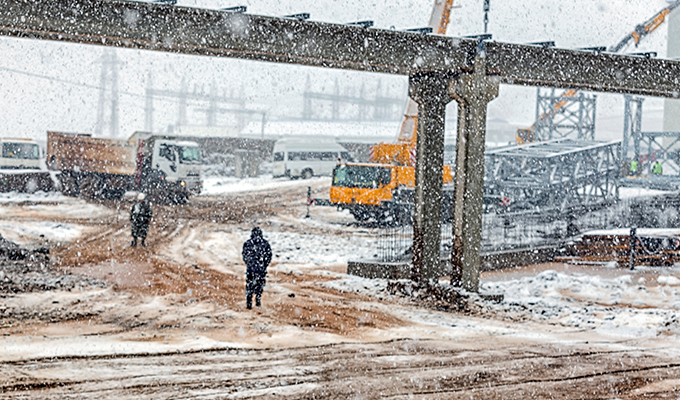By Jane Marsh
Winter might not be the prime season for construction, that doesn’t mean everything needs to grind to a halt just because the temperature starts falling. Here are some strategies contractors can use to survive and succeed during the winter construction season.
BE AWARE OF THE RISKS
The first step toward surviving cold weather when working outdoors is to understand the risks. The three most common cold-weather-related conditions are hypothermia, frostbite, and trench foot.
Hypothermia occurs when the body is exposed to cold temperatures for prolonged periods. Eventually, this can use up the body’s energy stores, causing various ailments starting with shivering and leading to fatigue, confusion, disorientation, and even death without treatment.
Frostbite occurs mostly in extremities when the tissues freeze, destroying the cells. Numbness and tingling are the first symptoms, followed by stinging and pain.
Trench foot happens when your feet are wet and cold. You don’t need freezing temperatures to suffer from trench foot. According to the Centers for Disease Control and Prevention, it can happen at temps as high as 60 degrees F.
Understanding the risks and, more importantly, knowing how to prevent them can make it easier to navigate winter construction.
WEAR APPROPRIATE CLOTHING
The next step in surviving winter construction is to ensure everyone on the jobsite is wearing appropriate clothing for the conditions. This should include:
- Layered clothing. In addition to keeping warm, you can remove layers if conditions change or warm up.
- Hats to conserve heat and protect ears.
- Gaiters or other face protection to prevent frostbite on the nose and face.
- Gloves to protect hands and fingers from frostbite.
- Waterproof or water-resistant work boots to reduce the risk of trench foot.
The goal is to ensure workers are protected from the elements but can remove layers if it’s cold in the morning and warmer in the afternoon.
PREVENT ICE AND SNOW PROBLEMS
Slipping and falling on ice can result in serious injury during the cold winter construction season. According to information collected by the Bureau of Labor Statistics, slips, trips, and falls were responsible for 37.9% of workplace fatalities in 2021 in the construction industry. Adding ice to the equation makes the risk of these incidents even higher.
Preventing these issues comes in multiple shapes and sizes. Treating walkways and work areas with salt or other de-icing chemicals can prevent ice formation. Adding shoe spikes or cleats to the dress code can provide more traction on slippery surfaces in areas where that isn’t possible. It is also essential for businesses to have a comprehensive workers’ compensation program in place for incidents that aren’t preventable.
TAKE FREQUENT BREAKS
Summers are getting hotter and winters are getting colder. Deadlines are important, but not at the cost of employee safety. When the temperature begins to drop, it’s essential to take frequent breaks in a warm space. Set up an office with a space heater or a portable, climate-controlled tent to keep workers comfortable.
While there are no specific standards or rules that govern working in the cold, a good rule of thumb is to take a 10-minute break to warm up for every 2 hours working in cold conditions.
KNOW WHEN TO CALL IT
With cold winters, we’ll run into a point where it becomes too chilly to safely work outdoors. It’s tempting to layer up, break out the hand warmers and push through, but that could end up putting workers in jeopardy, and no deadlines in the world are worth that.
Play it by ear, but know when to put your foot down and cancel work for the day if severe weather or extreme cold puts your crew at risk.
CLOSING THOUGHT
Spring and summer might be better for construction work, but things don’t have to stop just because the temperature starts to drop. Take precautions to stay warm and prevent cold-related illnesses this winter season.
About the Author
Jane Marsh is an environmental and green technology writer who covers topics in sustainable construction and green building materials. She also works as the editor-in-chief of Environment.co.


